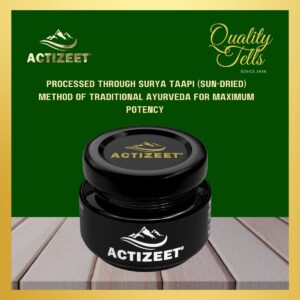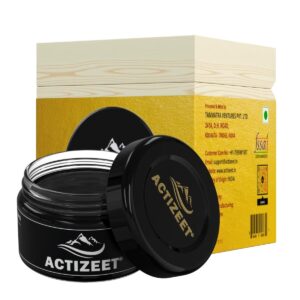Shilajit resin, also known as mineral pitch or mumijo, is a naturally occurring substance that has been revered for centuries in traditional Ayurvedic medicine. Derived from the Sanskrit word “shila” meaning rock and “jit” meaning conqueror, shilajit is believed to possess immense rejuvenating properties.
It is a sticky, tar-like substance that oozes out of cracks in the rocks of high mountain ranges, predominantly found in the Himalayas and Altai region. This prized resin is formed over centuries as plant matter decomposes and combines with minerals under extreme pressure.
Table of Contents
ToggleHistorical significance and traditional uses
Shilajit resin has a rich historical significance dating back thousands of years. It finds mention in ancient Ayurvedic texts as well as traditional medical practices from countries like India, Nepal, Russia, and China. In Ayurveda, shilajit is considered one of the most potent substances for promoting overall health and vitality.
It has been traditionally used to address a wide range of conditions, including fatigue, digestive disorders, immune system support, cognitive function enhancement, and even as an aphrodisiac. Due to its perceived rejuvenating effects on the body and mind, shilajit was often hailed as the “destroyer of weakness” or “conqueror of mountains” by ancient sages.
Shilajit’s association with longevity and vitality has also made it an integral part of various spiritual practices. Yogis would consume shilajit regularly to heighten their physical endurance during intense meditation sessions or spiritual retreats.
Its ability to enhance energy levels while promoting overall well-being made it highly sought after by those seeking optimal health. As we delve deeper into the composition and qualities of shilajit resin, we unravel the secrets behind its historical significance and why it continues to captivate the attention of wellness enthusiasts worldwide.
Understanding the Composition of Shilajit Resin
Geological formation and extraction process
Shilajit resin, also known as “rock sweat” in Sanskrit, is a natural substance that oozes out from the cracks of rocks in high-altitude mountains. It is primarily found in the Himalayas, the Altai Mountains, and other mountainous regions with unique geological formations. This extraordinary substance takes centuries to form through the gradual decomposition of plant matter and microorganisms.
The extraction process involves carefully collecting the resin as it seeps out of the rocks and then purifying it to remove any impurities. This ensures that we get a concentrated and potent form of shilajit for consumption.
Key components and nutritional profile
Shilajit resin is an intricate blend of various organic compounds, minerals, vitamins, and powerful bioactive substances that contribute to its remarkable health benefits. One of its notable components is fulvic acid, which plays a crucial role in enhancing nutrient absorption at a cellular level.
Additionally, shilajit resin contains numerous essential minerals, including iron, calcium, magnesium, zinc, copper, potassium, manganese, and selenium, all vital for maintaining optimal bodily functions. It also provides amino acids like alanine, glycine, and proline, which are building blocks for proteins.
Furthermore, this incredible substance includes vitamins B complex such as thiamine (B1), riboflavin (B2), niacin (B3), pantothenic acid (B5), pyridoxine (B6), folic acid (B9) which support overall well-being. Understanding these aspects allows us to appreciate how shilajit resin harnesses nature’s wisdom to offer a wide array of health benefits.
Evaluating the Quality of Shilajit Resin
Purity standards and certifications
When it comes to evaluating the quality of shilajit resin, purity standards and certifications play a crucial role. Look for products that are certified by reputable organizations, such as the International Organization for Standardization (ISO) or Good Manufacturing Practices (GMP) certifications. These certifications indicate that the product has undergone rigorous testing and meets stringent quality standards.
Additionally, check if the shilajit resin is free from contaminants such as heavy metals or harmful substances. Reputable manufacturers often provide lab test reports or certificates of analysis that assure you of the purity and safety of their products.
Factors affecting quality, such as sourcing and processing methods
Several factors can influence the quality of shilajit resin, making it essential to consider them before making a decision. The first factor is sourcing—where and how the shilajit resin is extracted from its natural habitat.
Shilajit sourced from high-altitude regions like the Himalayas or Altai Mountains tends to have higher concentrations of beneficial minerals due to unique geological conditions. Processing methods also play a crucial role in maintaining the potency of shilajit resin.
Look for products that undergo minimal processing and are made using cold water extraction techniques, as these methods help preserve their active compounds and nutritional content. Avoid products that involve excessive heat or chemical solvents during processing, as they may degrade the beneficial properties of shilajit resin.
Evaluating the quality of shilajit resin requires considering purity standards and certifications while also taking into account factors such as sourcing and processing methods. By ensuring high-quality standards are met, you can be confident in selecting a premium product that offers maximum health benefits derived from this precious natural substance.
Comparing Different Types of Shilajit Resin
Himalayan Shilajit vs. Altai Shilajit: Similarities and Differences
When it comes to comparing Himalayan Shilajit and Altai Shilajit, we find ourselves in a realm of majestic mountains and rich mineral deposits. Both of these varieties of shilajit resin share certain characteristics while embodying unique attributes. The key similarity lies in their origin, as both are sourced from remote regions renowned for their geological richness. However, the differences emerge when we explore the specific source regions and mineral compositions.
Geological Variations in Source Regions
Himalayan shilajit hails from the lofty peaks of the Himalayas, while Altai shilajit is extracted from the Altai Mountains in Central Asia. The geological variations between these two regions contribute to distinct qualities found in their respective shilajit resins.
The Himalayas, with their diverse range of rocks and minerals formed over millions of years, gift us with a shilajit that reflects this diversity. On the other hand, the Altai Mountains carry their geological history, giving rise to a unique essence within Altai shilajit.
Variations in Mineral Composition
The mineral composition between Himalayan and Altai shilajit exhibits subtle but noteworthy differences. Himalayan shilajit is recognized for its rich concentration of fulvic acid—an organic compound known for its beneficial properties—alongside an array of trace minerals like iron, calcium, magnesium, and manganese.
In contrast, Altai shilajit showcases a distinctive blend characterized by higher levels of zinc, copper, selenium, and potassium. These contrasting mineral profiles make each type suitable for different health concerns or desired outcomes.
Unique Benefits Associated with Each Type
While both Himalayan and Altai shilajit offer numerous health benefits, their unique compositions lend them specific advantages. Himalayan shilajit’s high fulvic acid content contributes to its reputed antioxidant and anti-inflammatory properties, supporting overall well-being. Altai shilajit, on the other hand, is renowned for its mineral-rich composition that promotes vitality, bone health, and cognitive functions.
Depending on individual needs and preferences, one may choose between these two types of shilajit resin to harness the desired benefits. In this sea of geological wonders and diverse mineral formations, it becomes crucial to understand the differences between varieties of shilajit resin.
By comparing Himalayan and Altai shilajit in terms of their source regions, mineral compositions, and unique benefits, one can make an informed decision when selecting the most suitable type for individual requirements. Remember to explore further as we delve into lesser-known varieties of this remarkable substance later in this article.
Determining the Best Shilajit Resin for Your Needs
Identifying Personal Health Goals or Concerns
When choosing the best shilajit resin for your needs, it is crucial to identify your personal health goals or concerns. Are you looking to boost your overall energy levels, improve cognitive function, or enhance athletic performance?
Do you have any specific health conditions like inflammation, joint pain, or low immunity that you want to address? Understanding your unique requirements will help you narrow down the options and select a shilajit resin that aligns with your desired outcomes.
Considering Specific Properties
Apart from personal health goals, considering the specific properties of shilajit resin is also important. One essential aspect to look for is the fulvic acid content, as it plays a significant role in various biological processes and nutrient absorption. Additionally, examining the mineral balance of different products can guide you towards finding a resin that complements your nutritional needs.
Some individuals may benefit more from higher iron or magnesium content, while others may prioritize trace minerals like zinc or copper. Assessing these factors will aid in finding the most suitable shilajit resin for you.
Reviewing Customer Feedback and Expert Recommendations
To further assist in determining the best shilajit resin option, it can be valuable to review customer feedback and seek expert recommendations. Reading reviews from other users who share similar health goals can provide insights into their experiences and outcomes.
Look for reputable sources like health forums or online communities where individuals discuss their experiences with different brands or types of shilajit resin. Additionally, seeking guidance from experts in the field can offer valuable advice based on scientific research and extensive knowledge of shilajit’s properties.
Tips on Purchasing Authentic Shilajit Resin Products
Recognizing Common Signs of Counterfeit Products
When purchasing shilajit resin, it is essential to be aware of common signs that indicate counterfeit products. Look out for unusually low prices, as genuine high-quality shilajit resin is a rare and valuable substance. Be cautious of products claiming miraculous overnight results or those lacking clear information about their sourcing and manufacturing processes.
Additionally, be sceptical of vendors or websites with poor customer reviews or lacking transparency regarding their product origins. Awareness and vigilance will help ensure that you invest in authentic shilajit resin.
Trusted Brands or Suppliers with a Reputation for Quality
To ensure the purchase of authentic and high-quality shilajit resin, it is advisable to opt for trusted brands or suppliers recognized for providing reliable products. Research reputable brands with positive customer feedback and well-established reputations within the health and wellness community.
Look for third-party certifications, such as GMP (Good Manufacturing Practices) compliance or organic certifications, which indicate adherence to strict quality standards. Relying on trusted sources will give you peace of mind knowing that you are purchasing genuine shilajit resin.
Dosage Recommendations for Shilajit Resin
Understanding dosage recommendations is crucial when incorporating shilajit resin into your daily routine. While specific dosages can vary depending on various factors like individual health conditions, body weight, and desired outcomes, general guidelines can serve as a starting point. As a dietary supplement, an average daily dosage ranging from 300mg to 500mg is often recommended.
However, individuals with specific health conditions or seeking targeted benefits may opt for higher dosages under medical supervision. It is always advisable to consult with a healthcare professional to determine the most appropriate dosage based on your unique circumstances.
Conclusion
In the quest for the best shilajit resin, it is crucial to align your choice with personal health goals and concerns. Consider properties like fulvic acid content and mineral balance while reviewing customer feedback and expert recommendations to make an informed decision.
Understanding general dosage recommendations ensures a safe and effective integration of shilajit into your well-being routine. Embrace the power of this remarkable substance and embark on a journey towards holistic vitality and rejuvenation that leaves you invigorated, revitalized, and ready to conquer life’s challenges with renewed vigour.
The Best Shilajit Resin
-
Himalayan Shilajit, Pure shilajit, Shilajit, SHUDDH SURYA TAPI SHILAJIT
Rated 4.74 out of 5₹4,950.00Original price was: ₹4,950.00.₹3,950.00Current price is: ₹3,950.00. Incl. GST ADD TO CART Buy Now -
Himalayan Shilajit, Pure shilajit, Shilajit, SHUDDH SURYA TAPI SHILAJIT
Rated 4.78 out of 5₹9,900.00Original price was: ₹9,900.00.₹6,450.00Current price is: ₹6,450.00. Incl. GST ADD TO CART Buy Now -
Himalayan Shilajit, Pure shilajit, Shilajit, SHUDDH SURYA TAPI SHILAJIT
Rated 4.74 out of 5₹3,450.00Original price was: ₹3,450.00.₹2,450.00Current price is: ₹2,450.00. Incl. GST ADD TO CART Buy Now -
Himalayan Shilajit, Pure shilajit, Shilajit, SHUDDH SURYA TAPI SHILAJIT
Rated 4.81 out of 5₹8,400.00Original price was: ₹8,400.00.₹5,450.00Current price is: ₹5,450.00. Incl. GST ADD TO CART Buy Now
Related posts:
- Unveiling the Best Shilajit in India: Your Ultimate Guide
- Unveiling the Best Shilajit: Discovering Which Shilajit is Good
- Unveiling the Purest Shilajit Brand: Discover Which Brand Reigns Pure
- Shilajit in Agartala (Tripura)
- Shilajit in Brunei
- Shilajit in Panaji (Goa)
- Shilajit in Srinagar (Kashmir)
- Shilajit in Malta







